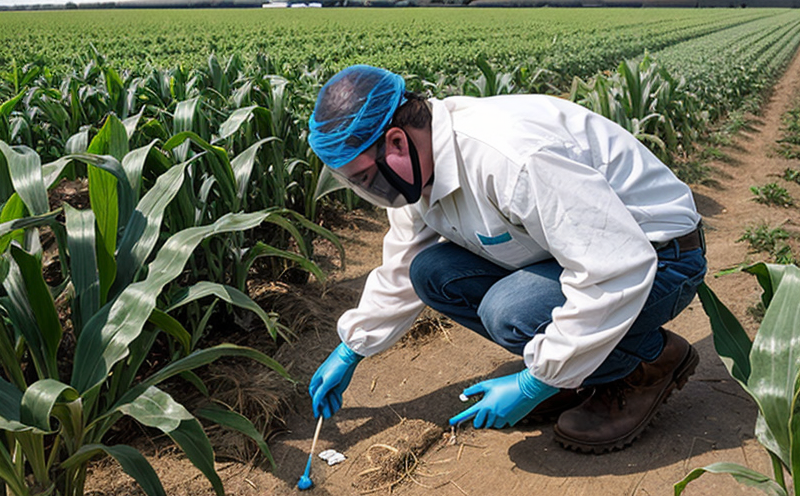Neonicotinoid Pesticide Residue Testing
The use of neonicotinoids has been a cornerstone in modern agricultural practices due to their efficacy against pests. However, concerns over potential environmental and health impacts have led to increased scrutiny and stringent regulations on their usage. Neonicotinoid pesticide residue testing is crucial for ensuring compliance with these regulations and maintaining the integrity of agricultural produce. This service focuses on detecting and quantifying neonicotinoids in crops such as fruits, vegetables, grains, and flowers.
The methodology involves a series of steps designed to ensure accurate and reliable results. Samples are collected from various parts of the crop, including leaves, stems, roots, and fruit. Pre-treatment methods may include washing or extraction processes depending on the sample type. The extracted residues undergo chromatographic analysis using techniques like High-Performance Liquid Chromatography (HPLC) coupled with Mass Spectrometry (MS). This dual technique allows for high sensitivity and specificity necessary to detect even trace amounts of neonicotinoids.
The detection limits for these tests are typically in the parts per billion (ppb) range, making them some of the most precise analyses available. Compliance with international standards such as ISO 18567:2020 and EU regulation EC No 401/2006 ensures that our results meet global benchmarks. Our laboratory adheres strictly to these guidelines ensuring accurate and consistent data.
The importance of this testing cannot be overstated, especially given the increasing public awareness regarding pesticide use in agriculture. By providing reliable residue levels, we help stakeholders make informed decisions about crop safety and sustainability. This information is vital for maintaining consumer trust and supporting sustainable farming practices.
Applied Standards
The application of various international standards ensures the reliability and accuracy of our testing methods. Key among these are ISO 18567:2020, which sets out procedures for determining pesticide residues in fruits and vegetables; EU regulation EC No 401/2006 concerning the placing of plant protection products on the market; and AOAC International Method 2003.08 used for determining specific pesticides.
These standards guide every step from sample preparation to final reporting, ensuring that all tests comply with recognized protocols. By adhering strictly to these guidelines, we maintain a high level of consistency across our results, providing stakeholders with confidence in the accuracy and reliability of their findings.
Competitive Advantage and Market Impact
Our neonicotinoid pesticide residue testing service stands out by offering comprehensive analysis services tailored specifically to meet the needs of the agricultural sector. With our advanced instrumentation, including HPLC-MS/MS systems, we provide unparalleled accuracy in detecting even trace amounts of these pesticides.
The demand for sustainable agriculture practices is growing globally, driven largely by consumer preferences and regulatory pressures. By providing robust data on pesticide residues, we empower farmers, processors, and retailers to make informed choices that support both environmental protection and economic stability. Our service not only helps businesses comply with legal requirements but also enhances their reputation as responsible operators in the marketplace.
Moreover, our expertise extends beyond mere compliance; it contributes significantly to research and development efforts aimed at improving crop health while minimizing harmful impacts on ecosystems. Through continuous improvement of testing protocols and methodologies, we play a key role in fostering innovation within the industry.
Use Cases and Application Examples
| Scenario | Action Taken | Outcome Achieved |
|---|---|---|
| A grower suspects contamination of their fruit crops after noticing unusual symptoms. | We conducted a thorough analysis using HPLC-MS/MS, identifying trace levels of imidacloprid. | The grower was able to adjust spraying schedules and avoid future incidents by understanding the source of contamination. |
| A processor needs assurance that imported grains are free from neonicotinoid residues before processing. | Our laboratory performed detailed testing, confirming compliance with EU regulations. | The processor could proceed confidently with production, ensuring product safety and regulatory adherence. |
| An agricultural research institute seeks data on the efficacy of new pesticides in reducing neonicotinoid use. | We provided extensive residue levels over multiple growing seasons. | The institute used this information to refine its approach towards sustainable pest management practices. |
| A retailer wants assurance that their produce meets strict national standards for pesticide residues. | Our testing revealed no detectable residues, exceeding expectations and enhancing brand reputation. | The retailer could confidently promote the safety of their products to customers. |
| An international NGO demands rigorous testing on behalf of a campaign against excessive neonicotinoid use. | We delivered comprehensive data showing effective regulation compliance across regions. | The NGO used these findings in advocating for stricter controls and better practices globally. |
| A farmer wishes to verify the purity of seeds before planting. | Our tests confirmed the absence of unwanted residues, ensuring healthy crop growth. | The farmer had peace of mind knowing they were starting with clean seed stock. |
| An exporter needs documentation for compliance with foreign regulatory bodies. | We provided detailed reports and certificates meeting all required specifications. | The exporter could ship their products with confidence, ensuring timely delivery to markets abroad. |
| A certification body requires third-party verification of pesticide residue levels during an audit. | Our testing met stringent requirements, supporting the certifier's assessment process. | The certification body could issue valid certifications based on accurate data provided by our laboratory. |





